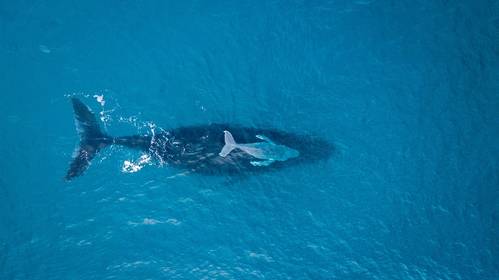Whale Song
Who is listening to whale song? Quite a lot of people it turns out, and those who are filtering it out of their data are missing an opportunity for greater understanding of humans, whales and oceans.
Earlier this year, a group of linguists, developmental scientists, marine biologists and behavioral ecologists from Griffith University in Australia considered how human babies discover words in speech and how this might be related to the fact that language is culturally transmitted.
There’s a law that is relevant: Zipf's law which when applied to language states that the most common word occurs about n times the n-th most common one. As an example, “the” is often about twice as commonly used in written text as the next most common word “of”. Apparently, “the” accounts for nearly 7% of all word occurrences and “of” accounts for around 3.5%. "And" comes in third at about 2.8%.
The Griffith University team studied eight years of humpback recordings and found these same statistical characteristics present in whale song.
In humans, these properties help language be passed from one generation to the next. Perhaps the same is true for whales.
MBARI also released some research on whale song this year – highlighting how it reveals information about the ecology of whales and the health of oceans. Again, an interdisciplinary team of collaborators examined the data. They were able to link characteristics of blue and humpback whale song to the relative availability of their food, in this case influenced by an ocean heatwave event.
The researchers hope that their findings will help scientists and resource managers predict how marine ecosystems and species will respond to climate change. Listening to whale song is much more than a rich sensing experience, they say. It is a window into their lives, their vulnerability and their resilience.
Because sound travels so efficiently through water, whale song can be detected if the whale is anywhere within an area thousands of square kilometers around a hydrophone.
It can also be detected on land, according to a study published in Nature last week.
Physicists from Dublin Institute for Advanced Studies point out that while monitoring whale song using ocean-deployed hydrophones plays an important role in the study of whale distribution and social behavior, obtaining real-time data remains challenging.
They demonstrate that fin whale song is being recorded by land-based seismic installations as much as 5.5km inland from the ocean. The frequencies contained in the songs travel in solid earth as seismic waves.
Landside stations, along with seismometers used by citizen scientists, are typically used for detecting earthquakes, and the songs are automatically filtered out.
Left in, say the researchers, they could be used to enhance public engagement with the ocean and to provide new opportunities for the global monitoring of whales.
What untapped potential might this hold is anyone’s guess.















 December 2025
December 2025



